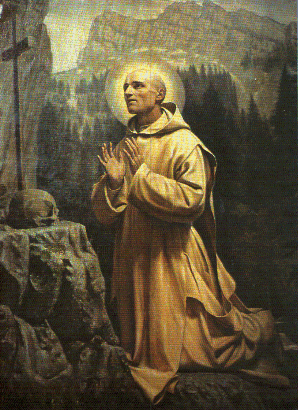St. Bruno, Founder of the Carthusian Order

(The following is the legend of the breviary for St. Bruno, as quoted in Dom Prosper Guéranger's entry in The Liturgical Year for October 6, in Volume XIV of the 1983 Marian House edition of the English translation by the Benedictines of Stanbrook.)
"Bruno, the founder of the Carthusian Order, was born at Cologne [Germany], and from his very cradle gave great promise of future sanctity. Favoured by divine grace, the gravity of his character made him shun all childishness; so that, even at that age, one might have foreseen in him the future father of monks and restorer of the anachoretical life [life of a hermit]. His parents, who were distinguished for virtue and nobility, sent him to Paris, where he made great progress in philosophy and theology, and took the degrees of doctor and master in both faculties. Soon after this, he was, for his remarkable virtue, appointed to a canonry in the church of Rheims [France]."
"After some years, Bruno, with six of his friends, renounced the world, and betook himself to [St.] Hugh [of Châteauneuf], bishop of Grenoble [France]. On learning the cause of their coming, the bishop understood that they had been signified by the seven stars he had seen falling at his feet in his dream of the previous night. He therefore made over to them some wild mountains called the Chartreuse, belonging to his diocese, and himself conducted them thither. After having there led an eremitical life for several years, Bruno was summoned to Rome by [Pope] Urban II who had been his disciple. In the great trials through which the Church was then passing, the Pontiff gladly availed himself of the saint's prudence and knowledge for some years, until Bruno, refusing the archbishopric of Reggio [Italy, probably the town on the tip opposite of Sicily], obtained leave to retire."
"Attracted by the love of solitude he went to a desert place near Squillace in Calabria. Count Roger of Calabria was one day hunting, when his dogs began to bark round the saint's cave. The Count entered and found Bruno at his prayers, and was so struck by his holiness, that thenceforward he greatly honoured him and his companions and supplied their wants. His generosity met with its reward. A little later, when this same Count Roger was besieging Capua, and Sergius, an officer of his guard, had determined to betray him, Bruno, who was still living in the desert [place], appeared to the Count in sleep, revealed the whole treason to him, and thus saved him from imminent peril. At length, full of virtues and merits, and as renowned for holiness as for learning, Bruno fell asleep in our Lord [on 6 October 1101], and was buried in the monastery of St. Stephen built by Count Roger, where he is greatly honour to this day."
[St. Bruno's community of Carthusians in the Chartreuse Mountains is still there, after 900+ years. German filmmaker Philip Gröning made a documentary, released in 2005, called "Into Great Silence," which I highly recommend. Below is the official U.S. trailer for the movie.]


1 Comments:
I was just wondering, what is the title and painter of the painting of St. Bruno you have posted?
Post a Comment
<< Home